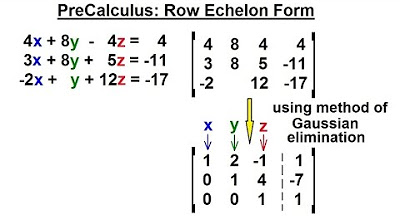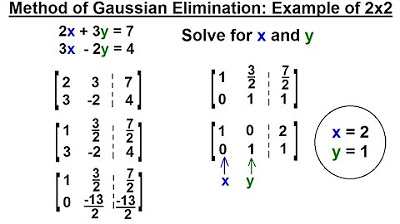Part 1, Solving Using Matrices and Cramer's Rule
TLDRThe video introduces a novel method for solving systems of linear equations using matrices, specifically Cramer's Rule. It demonstrates the process with a step-by-step example involving two variables, highlighting the efficiency of this technique for more complex systems with multiple variables and equations. The video emphasizes the reduced likelihood of errors and time-saving benefits of Cramer's Rule over traditional methods, and teases an upcoming example with three variables to further illustrate its value.
Takeaways
- 📚 Introduction to Cramer's Rule: The script introduces Cramer's Rule as a method for solving systems of linear equations using matrices, which is particularly useful for systems with three or more variables.
- 🔢 Determinant Calculation: It explains the process of calculating the determinant of the coefficient matrix, which is fundamental to Cramer's Rule.
- 📌 Matrix Setup: The script outlines the initial setup of the matrix by extracting coefficients from the given equations to form the determinant.
- 🤔 Substitution Process: It details the process of substitution, where specific elements are replaced to find the determinants for the individual variables (DX and DY).
- 📊 Determinant for X: The script demonstrates how to find the value for DX by substituting the column related to X and calculating the determinant.
- 📊 Determinant for Y: Similarly, it shows how to find DY by focusing on the column related to Y and performing the determinant calculation.
- 🔍 Solving for X: The method for solving for X is explained by dividing DX by D, the original determinant, to find the value of X.
- 🔍 Solving for Y: The script describes how to solve for Y by dividing DY by D, yielding the value of Y.
- 👍 Advantages of Cramer's Rule: The script highlights the advantages of Cramer's Rule, especially in saving time and reducing the chance of errors when dealing with multiple variables.
- 📈 Complexity with More Variables: It acknowledges that while Cramer's Rule is efficient for higher variable counts, it may be less efficient for simple two-variable systems.
- 🎥 Upcoming Content: The script teases future content, promising an example with three variables to further illustrate the value of Cramer's Rule.
Q & A
What is Cramer's Rule?
-Cramer's Rule is a method for solving a system of linear equations with as many equations as there are variables, using determinants of matrices.
How does Cramer's Rule differ from other methods like substitution or elimination?
-Cramer's Rule uses the concept of determinants of matrices to find the solution, which can be advantageous when dealing with systems of equations involving three or more variables, where other methods may become more complex and time-consuming.
What is the first step in applying Cramer's Rule?
-The first step is to form the matrix of coefficients by taking the coefficients of the variables from the system of equations.
How do you calculate the determinant of a matrix in Cramer's Rule?
-For a 2x2 matrix, the determinant is calculated as (a*d) - (b*c), where a, b, c, and d are the elements of the first two rows and columns of the matrix.
What is DX in the context of Cramer's Rule?
-DX represents the determinant of a modified matrix where the column corresponding to the variable X (the first column) has been replaced with the constants from the right side of the equations.
What is DY in the context of Cramer's Rule?
-DY represents the determinant of another modified matrix, similar to DX, but with the second column (corresponding to the variable Y) being replaced with the constants from the right side of the equations.
How do you find the value of X using Cramer's Rule?
-To find the value of X, you divide DX by the determinant D. The result gives you the value of X.
How do you find the value of Y using Cramer's Rule?
-To find the value of Y, you divide DY by the determinant D. The result gives you the value of Y.
Why might Cramer's Rule be preferred over other methods for systems with more variables?
-Cramer's Rule can be more efficient for systems with three or more variables because it simplifies the process of solving, reducing the chance of error and saving time compared to methods like elimination or substitution.
What is the main takeaway from the video script for someone learning Cramer's Rule?
-The main takeaway is that Cramer's Rule provides an alternative method for solving systems of linear equations, especially useful for systems with multiple variables, and can be more efficient and less prone to mistakes in those scenarios.
How does the video script illustrate the application of Cramer's Rule?
-The video script walks through a step-by-step process of applying Cramer's Rule to a system of two linear equations with two variables, showing how to calculate the determinants and use them to find the values of X and Y.
Outlines
📚 Introduction to Cramer's Rule
The paragraph introduces a novel method for solving systems of linear equations, Cramer's Rule, which utilizes matrices. It contrasts this approach with more traditional methods like elimination and substitution. The explanation begins with setting up the determinant of the coefficient matrix, using coefficients from a given system of two equations with two variables. The process of calculating the determinant to find the value of D is described in detail.
🔍 Calculation of DX and DY
This section delves into the specific steps for calculating DX and DY, which are essential for applying Cramer's Rule. It explains how to modify the coefficient matrix by replacing elements to form new matrices for which the determinants are then computed. The paragraph outlines the process of finding DX by replacing the first column with the constants from the right side of the equations and similarly, finding DY by considering only the first column and modifying the rest of the matrix accordingly. The arithmetic involved in these calculations is also explained.
Mindmap
Keywords
💡Cramer's Rule
💡Matrices
💡Determinant
💡Linear Equations
💡Substitution
💡Elimination
💡Variables
💡Coefficients
💡Video Script
💡Educational Content
💡Solving Equations
Highlights
Introduction to a new method for solving systems of equations using matrices.
Explaining Cramer's Rule as an alternative to elimination and substitution methods.
Step-by-step process of finding the determinant of the coefficient matrix.
Calculation of the determinant resulting in the value of 10.
Procedure for finding DX by replacing elements in the first column and recalculating the determinant.
Result of DX calculation, obtaining a value of negative 20.
Explanation of how to find DY by altering the first column and calculating the determinant again.
DY calculation resulting in a value of 5.
Method to find the value of X by dividing DX by D.
Determination of X's value as negative 2.
Process for finding the value of Y by dividing DY by D.
Conclusion that Y equals two and a half or 2.5.
Discussion on the practicality and efficiency of Cramer's Rule for higher variables and equations.
Advantages of Cramer's Rule in reducing the time and effort required to solve complex systems of equations.
Preview of an upcoming video demonstrating Cramer's Rule with three variables.
Encouragement for viewers to subscribe and engage with the content.
Transcripts
Browse More Related Video

PreCalculus - Matrices & Matrix Applications (32 of 33) Using Cramer's Rule to Find x=? y=?

Solving Systems Using Cramer's Rule

PreCalculus - Matrices & Matrix Applications (3 of 33) Row Echelon Form

Substitution Method For Solving Systems of Linear Equations, 2 and 3 Variables, Algebra 2

PreCalculus - Matrices & Matrix Applications (6 of 33) Method of Gaussian Elimination: 2x2 Matrix

Elimination Method For Solving Systems of Linear Equations Using Addition and Multiplication, Algebr
5.0 / 5 (0 votes)
Thanks for rating: